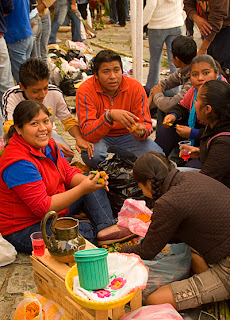 |
| Day of the Dead Atzompa Cemetery, Oaxaca Mexico |
Technical Considerations When Making Photos In A Darkened Cemetery
May 2014 UpdateThe Day Of The Dead in Oaxaca, Mexico promises to be something special this year as a moderate recovery of the local economy and renewed tourism will make it a festive time.
To make photos in the cemetery under not much more than candlelight will still be difficult but perhaps this year there will be more candles and more carefully prepared tombs and altars. (offering tables)
The people of the towns and villages visit the cemetery in the dark of night and set it ablaze with thousands of candles. The families then sit by the gravestones in a night vigil. Musicians gather and chant as the scent of Copal incense and the perfume of marigold flowers fills the air. This can be disorienting to the first time visitor. We offer a few tips here that might help you make some memorable cemetery photos
The best bet is to arrive at the cemetery before dusk if possible. In this way you can familiarize yourself with the layout of the gravesites. Choose a few groupings that might make a good composition. The afternoon is also a good time to make photos of the preparations that will be underway. (Link) People will be cleaning and decorating tombs. You might make a connection with a family and then return to the grave later after they light the candles. In most cases it is best to say hello and ask if you can take a photo. The people are proud of their decorations and for the most part they welcome visitors.
Once darkness comes, about 7:00 pm on October 31 in the tropics, you will be forced to use slow shutter speeds or long exposures to make photos. The length or duration of the exposure will depend on the number of candles arrayed on the tomb or gravesite, but extended exposure time will be the working mode for cemetery photos. This is particularly true if you will sell your photos or present them as prints or in digital presentations. The ultra high ISO available with high-end cameras (6400) (with resulting faster shutter speed) might not reproduce well in prints or digital shows (slide shows) therefore steadying technique or a tripod will be needed. Tripods are acceptable and indispensable in cemetery photos if you want to make a variety of photos and photos that you can sell. (link)
 |
Daylight photos of the altars in the
shops and streets of Oxaca
|
The shutter speeds will beat least a I/4 second and as much as 4 seconds when the aperture is set at f-8. Shutter speeds over 2 seconds might show the candles as too bright; the flame will loose its shape. With a slow shutter speed you will need a tripod or you will need to support the camera on a stable object.
The shutter speed will depend on the amount of light generated by the candles. An aperture of f-8 is a good compromise in this situation except where you want to show maximum depth of field. As in the photo of the sand painting (Link) shown on this web page.
The aperture in this photo was set at f-16 with a 6 second exposure. The candles were encased in glass containers which therefore did not show effects from the wind. Two figures in the background show motion but it is hardly discernible.
In this photo the camera rested on a camera bag to achieve the sharpness and absence of camera shake. The camera's ten second timer released the shutter.
Aperture
With a digital SLR you can set apertures and shutter speed in manual mode. You will need to work in manual mode including manual focus to achieve predictable results.Auto Focus Problems
Two problems come into play with auto focus.Camera lenses don't always focus well in dark situations; they tend to hunt and this will prevent you from taking photos. The other problem is that people will be walking in front of you while you are focusing. The lens will sense the movement and tend to hunt as the people move. For these reasons it is best to manually focus the lens.
It is best to find a good subject and place your tripod. Ask permission to make photos if appropriate, and make a series of photos at a well-composed group of gravesites. One good photo of one gravesite is better than 50 bad photos of 50 gravesites.
If you stay in one place you become invisible to the subjects who get used to you after a few minutes. You begin to understand better the ebb and flow of the action about you and the wind effects on the candles. Your eyes accustom to the light levels and you see more composition opportunities. With your tripod in place you can time your shots between the movement of visitors walking throughout the cemetery.
With a tripod you also can more accurately manual focus. Once set, you need not change the focus unless you zoom in or out. Tips Page, Composition
People who move in front of you are not usually a problem in a long exposure as long as they keep moving. When they do stay in motion they don't show in the frame because there is not enough light on them. The family at the gravesite usually sits still at the edge of the grave and this results in no motion blur.
Once you plant a tripod and your eyes become accustomed to the light levels you can experiment with different lenses, different angles of view, high or low, left or right, and you can isolate parts of the scene that you find pleasing.
Related Links
Day of the Dead Atzompa
Day of the Dead Xoxocotlon
















